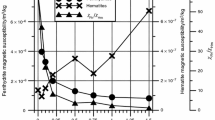Abstract
Natural iron-bearing rutile, formed under low temperature hydrothermal conditions, is chemically homogeneous on an electron-microscope scale (at a resolution of about 10 Å). On annealing at temperatures between 475° and 600° C precipitation of an iron-rich phase occurs. The precipitation sequence involves two transitional stages before the formation of hematite, the equilibrium precipitate. The first phase is coherent with the rutile structure and has the general characteristics of Guinier-Preston zones. The second transitional phase is a monoclinic variant of the rutile structure and is partially coherent with the matrix. Annealing experiments enable a Time-Temperature-Transformation (TTT) plot to be constructed for the exsolution process and the kinetics are interpreted in terms of the structural changes involved at each stage of the process.
Similar content being viewed by others
References
Aaronson, H.I., Aaron, H.B., Kinsman, K.R.: Origins of microstructures resulting from precipitation. Metallography 4, 1–42 (1971)
Anderson, J.S., Tilley, R.J.D.: Crystallographic shear in oxygen-deficient rutile: an electron microscope study. J. Solid State Chem. 2, 472–482 (1970)
Buravikhin, V.A., Litwintsev, V.V., Ushakov, A.I.: Polymorphic transformations and physical properties of thin films. Phys. Status Solidi (A) 40, 11–27 (1977)
Brusill, L.A.: An electron microscope study of the FeO-Fe2O3-TiO2 system and of the nature of iron-doped rutile. J. Solid State Chem. 10, 72–94 (1974)
Chadwick, G.A.: Metallography of phase transformations. London: Butterworths 1972
Champness, P.E., Lorimer, G.W.: Exsolution in silicates. In: Electron microscopy in mineralogy, Wenk, H.R. (ed.) Berlin Heidelberg New York: Springer 1976, pp. 174–204
Hirsch, P.B., Howie, A., Nicholson, R.B., Pashley, D.W., Whelan, M.J.: Electron microscopy of thin crystals. London: Butterworths 1965
Hyde, B.G.: Rutile: Planar defects and derived structures. In: Electron microscopy in mineralogy, Wenk, H.R. (ed.) Berlin Heidelberg New York: Springer 1976, pp. 310–318
Lindsley, D.H.: Iron-titanium oxides. Carnegie Inst. Washington Year Book 64, 144–148 (1965)
Lindsley, D. H.: Experimental studies of oxide minerals. Min. Soc. Am. Short Course Notes Vol. 3, 1976
MacChesney, J.B., Muan, A.: The system iron oxide-TiO2-SiO2 in air. J. Am. Ceram. Soc. 43, 586–591 (1960)
McConnell, J.D.C.: Microstructures of minerals as petrogenetic indicators. Ann. Rev. Earth Planet. Sci. 3, 129–155 (1975)
Putnis, A. Wilson, M.M.: A study of iron-bearing rutiles in the paragenesis TiO2-Al2O3-P2O5-SiO2. Mineral. Mag. 42, No. 322 (1978), In press
Shewmon, P.G.: Transformations in metals. New York: McGraw-Hill 1969
Verhoeven, J.D.: Fundamentals of Physical Metallurgy. New York-London-Sydney Toronto: Wiley 1975
Webster, A.H., Bright, N.F.H.: The system iron-titanium-oxygen at 1200° C and oxygen partial pressures between 1 atm and 2×10−14 atm. J. Am. Ceram. Soc. 44, 110–116 (1961)
Author information
Authors and Affiliations
Rights and permissions
About this article
Cite this article
Putnis, A. The mechanism of exsolution of hematite from iron-bearing rutile. Phys Chem Minerals 3, 183–197 (1978). https://doi.org/10.1007/BF00308121
Received:
Issue Date:
DOI: https://doi.org/10.1007/BF00308121




